|
||
|---|---|---|
Argentina 2010Ice Climbing on the Italian Glacier . . . January 18, 2010(see Google Earth Photo for Route from Base Camp to the Italian Glacier)
We gave thought to trying to score another of the valley's 6000 meter peaks before we were scheduled to hike out but the thought of squeezing one into three days and then hiking the 18 miles to Santa Ana on the day after was not real appealing. Instead we figured to hike out a day early and spend the extra day in or around Mendoza. So what to do? Well, Bob had never climbed ice . . .
We had breakfast at about 8 a.m. as we were in no real hurry and we did not have far to go. We packed the ice gear, all the screws we brought, a rope, crampons, technical axes, harnesses . . . all the glacier gear, and started walking. We made short work of the walk up valley and then stated to climb and began to feel a bit of the rest we did not get the day before. We made our way through the Piedras and out onto the flat of the Valle Superior. The flats of the Valle Superior have a number of boulders and we did stop at one to clown around a bit, shoot some photos We crossed the streams with dry feet through judicious use of rocks here and there as well as a few well placed leaps of faith. The bottom of the Italian Glacier is composed of a semi melting mix of rock and ice . . . all piled into a huge dark mass that here and there reminds one of its living nature. We climbed through talus, scree, ice and the mix of all three, taking time to avoid the sections that were sloughing in the We stopped for a bite and then poked around the seracs until we found one with a reasonable face and some sun to stand in. This was all new to Bob so he was all eyes and ears as we pulled gear from he packs and talked him through some of the basic concepts. Once we were geared up, I led a Once we all had a climb, I went about half way up the face and put in two ice threads, something I'd not done since our last failed attempt to climb the tongue on Canada's Haddo Aberdeen in 2003. With two threads in, I descended and Bob took a second turn, this time building a equalized two screw belay stance. G followed with another traverse before we all We made good time back to camp and on the way decided that the next day would be a true rest day as we had decided to come out on Thursday in one push rather than breaking the descent to Santa Ana into two easy nine mile days. Though we felt great, we really figured that a solid day of rest would make that 18 mile trek a lot easier.
next page
|

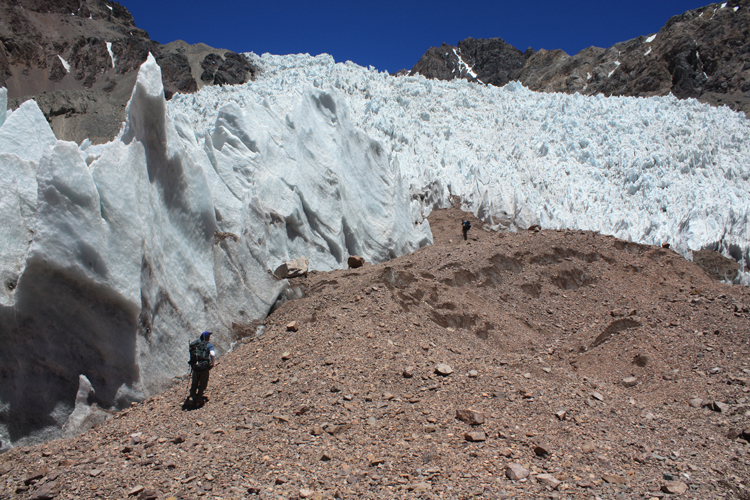
 There is not classic flat topped glacier in close proximity to the base camp so the idea of roping up for some glacier practice, doing a "z" pulley practice session and looking down some crevasses was not going to happen. Instead we were left with the seracs at the bottom of the Italian glacier which is conveniently located just up the trail a bit in the Valle Superior. I hope you can see where this is going by this point
There is not classic flat topped glacier in close proximity to the base camp so the idea of roping up for some glacier practice, doing a "z" pulley practice session and looking down some crevasses was not going to happen. Instead we were left with the seracs at the bottom of the Italian glacier which is conveniently located just up the trail a bit in the Valle Superior. I hope you can see where this is going by this point 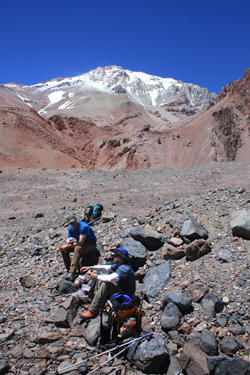 in the narrative. Yes, the toe of the glacier is just a short walk of almost three miles and 1400 feet of climb, literally just up the valley a bit, past the Piedras Coloradas and then across the flats of the Valle Superior. It was the usual drill, looks short, walks long; seems short, is high.
in the narrative. Yes, the toe of the glacier is just a short walk of almost three miles and 1400 feet of climb, literally just up the valley a bit, past the Piedras Coloradas and then across the flats of the Valle Superior. It was the usual drill, looks short, walks long; seems short, is high.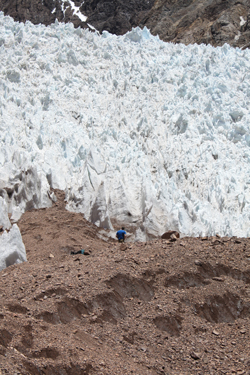 and wonder just why didn't we bring sandals to get across the melt water flows coming from the toe of the Italian Glacier. Hell if we knew.
and wonder just why didn't we bring sandals to get across the melt water flows coming from the toe of the Italian Glacier. Hell if we knew. sunlight. We eventually made it to the seracs that we had seen days before from the other side of the valley on our climb of Ramada. Those little seracs that we figured were about 6 or 8 feet high were pushing 40 and 50 feet and there was no doubt that we would find some place to put turn an ice screw or two.
sunlight. We eventually made it to the seracs that we had seen days before from the other side of the valley on our climb of Ramada. Those little seracs that we figured were about 6 or 8 feet high were pushing 40 and 50 feet and there was no doubt that we would find some place to put turn an ice screw or two.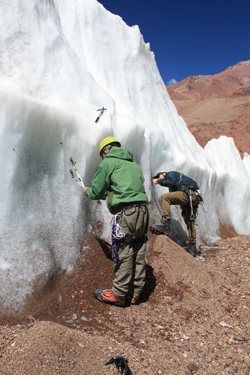 traverse across the face of a serac, no more than 15 feet up, placing screws every ten feet or so to practice something I'd not done in three or four years. Bob was next, climbing up where I descended and pulling the gear that I placed on my traverse. G took a turn next, placing screws, again for practice.
traverse across the face of a serac, no more than 15 feet up, placing screws every ten feet or so to practice something I'd not done in three or four years. Bob was next, climbing up where I descended and pulling the gear that I placed on my traverse. G took a turn next, placing screws, again for practice.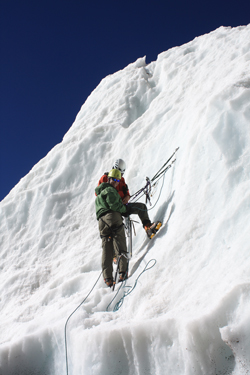 took turns practicing with ice threads on the base of the serac. Soon enough, we were running out of time if we wanted to get back to camp before nightfall so we finished with Bob recreating the traverse that I started off with and then I followed with Bob belaying me from the equalized stance. Once I arrived at the stance, Bob rappelled the short distance to the ground so that I could clean the gear. I shifted to the two thread placements and soon enough, I too was on the ground and we were packing gear for the walk back to camp.
took turns practicing with ice threads on the base of the serac. Soon enough, we were running out of time if we wanted to get back to camp before nightfall so we finished with Bob recreating the traverse that I started off with and then I followed with Bob belaying me from the equalized stance. Once I arrived at the stance, Bob rappelled the short distance to the ground so that I could clean the gear. I shifted to the two thread placements and soon enough, I too was on the ground and we were packing gear for the walk back to camp.